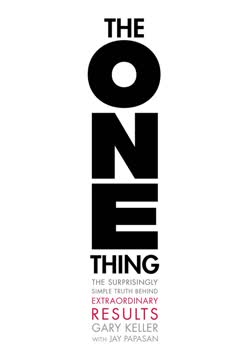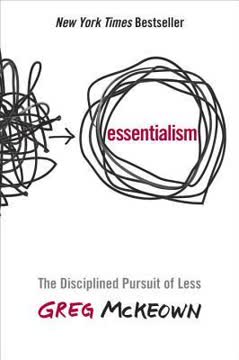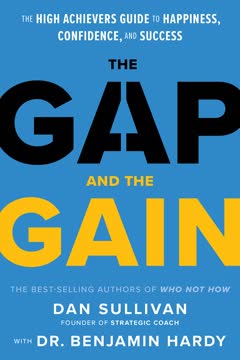Key Takeaways
1. Redefine Your Year: 12 Weeks, Not 12 Months
The 12 Week Year creates a new endgame date for you to assess your success (or lack thereof).
Break free from annualized thinking. The traditional 12-month year often leads to procrastination and a lack of urgency. By redefining a year as 12 weeks, you create a sense of immediacy and focus that drives action. This shorter time frame allows for:
- More predictable planning and execution
- Greater focus on critical priorities
- Increased accountability and motivation
The 12 Week Year concept eliminates the "year-end push" mentality and replaces it with continuous high performance. Every 12 weeks becomes a fresh start, allowing you to quickly adapt and refocus your efforts.
2. Create a Compelling Vision for Your Future
Vision is the starting point of all high performance. You create things twice; first mentally, then physically.
Craft a powerful personal vision. Your vision serves as the emotional fuel that drives your actions and helps you overcome obstacles. To create an effective vision:
- Imagine your ideal future in all areas of life (personal, professional, financial, etc.)
- Make it specific, measurable, and emotionally compelling
- Align your short-term goals with your long-term vision
A strong vision provides clarity and motivation, helping you push through discomfort and stay committed to your goals. Regularly review and connect with your vision to maintain focus and inspiration.
3. Develop a 12-Week Plan with Clear Goals and Actions
An effective plan clarifies and focuses on the top-priority initiatives and actions needed to achieve the vision.
Create an action-based plan. Your 12-week plan should bridge the gap between your vision and daily actions. To develop an effective plan:
- Set 1-3 specific, measurable goals for the 12-week period
- Identify the critical few actions (tactics) needed to achieve each goal
- Assign due dates to each tactic within the 12-week timeframe
Key elements of a strong 12-week plan:
- Specific and measurable goals
- Realistic but stretching targets
- Clear, actionable tactics
- Individual accountability for each item
- Time-bound deadlines
Remember, less is more. Focus on the vital few actions that will drive the most significant results.
4. Execute Weekly Plans and Score Your Performance
Measurement drives the execution process. It is the anchor of reality.
Implement a weekly routine. Break your 12-week plan into weekly action plans and score your execution. This process includes:
- Score the previous week's performance
- Plan the upcoming week based on your 12-week plan
- Participate in a Weekly Accountability Meeting (WAM)
Track both lead and lag indicators:
- Lead indicators: Actions taken (e.g., sales calls made)
- Lag indicators: Results achieved (e.g., sales closed)
Aim for an 85% execution rate on your weekly plans. This level of consistency will likely lead to achieving your 12-week goals. Regular scoring keeps you honest about your performance and allows for timely adjustments.
5. Master Time Management with Strategic Blocks
If you are not in control of your time, you are not in control of your results.
Implement Performance Time. This time-blocking system helps you allocate your time intentionally to high-value activities. The three core components are:
- Strategic Blocks: 3-hour periods of uninterrupted focus on important, non-urgent tasks
- Buffer Blocks: 30-60 minute periods to handle low-value activities and unexpected issues
- Breakout Blocks: 3-hour periods away from work to refresh and rejuvenate
Create a model work week that incorporates these blocks and your other critical activities. This structure ensures you dedicate time to strategic priorities while efficiently managing day-to-day tasks.
6. Embrace Accountability as Ownership, Not Consequences
Accountability is not consequences; it's ownership.
Shift your mindset on accountability. True accountability is about taking ownership of your actions and results, regardless of circumstances. To foster greater accountability:
- Resolve never to be the victim again
- Stop feeling sorry for yourself
- Be willing to take different actions
- Associate with "Accountables"
Accountability empowers you to focus on what you can control – your thinking and actions. By embracing this principle, you increase your ability to achieve your goals and create the life you desire.
7. Make and Keep Powerful Commitments
Commitment is the state of being bound emotionally or intellectually to a course of action.
Harness the power of commitments. Both personal commitments and promises to others can drive significant change. To make effective commitments:
- Establish a strong desire for the outcome
- Identify keystone actions that will have the biggest impact
- Count the costs and be willing to pay them
- Act on commitments, not feelings
For promises to others:
- Value your word and the impact of keeping (or breaking) promises
- Be willing to say "no" to avoid overcommitting
- Renegotiate quickly if you realize you can't fulfill a promise
Consistently keeping commitments builds self-confidence, strengthens relationships, and accelerates progress toward your goals.
8. Overcome Resistance and Navigate the Emotional Cycle of Change
Every time you complete the cycle, you build not only your capacity, but also your confidence.
Understand and prepare for resistance. Change is uncomfortable, and you will face internal and external barriers. Common challenges include:
- The need for immediate gratification
- Attempting too many changes at once
- Ingrained habits and routines
- Victim thinking
To overcome these obstacles:
- Connect daily actions to your compelling vision
- Focus on one or two key goals at a time
- Build new habits gradually
- Take ownership of your choices and results
Recognize the Emotional Cycle of Change:
- Uninformed optimism
- Informed pessimism
- Valley of despair
- Informed optimism
- Success and fulfillment
By anticipating these stages, you can better navigate the challenges and persist through difficult periods. Remember, each time you successfully implement change, you build capacity and confidence for future growth.
Last updated:
FAQ
What's "The 12 Week Year" about?
- Concept Overview: "The 12 Week Year" by Brian P. Moran and Michael Lennington is about redefining the traditional annual planning cycle into a 12-week period, allowing individuals and organizations to achieve more in less time.
- Execution Focus: The book emphasizes the importance of execution over planning, suggesting that shorter time frames create a sense of urgency and focus that leads to better results.
- Systematic Approach: It introduces a structured system that includes setting goals, creating a 12-week plan, and measuring progress to ensure consistent execution.
- Personal and Professional Growth: The principles can be applied to both personal and professional goals, helping readers to improve their productivity and achieve their potential.
Why should I read "The 12 Week Year"?
- Increased Productivity: The book offers a proven method to significantly increase productivity by focusing on shorter, more intense periods of work.
- Goal Achievement: It provides a framework for setting and achieving goals more effectively, which can lead to personal and professional growth.
- Execution Over Planning: The emphasis on execution rather than just planning helps readers to take actionable steps towards their goals.
- Practical Tools: The book includes practical tools and strategies that can be immediately applied to improve time management and focus.
What are the key takeaways of "The 12 Week Year"?
- Redefine the Year: Treat 12 weeks as a year to create urgency and focus, leading to better execution and results.
- Vision and Planning: Establish a compelling vision and create a detailed 12-week plan to guide actions and decisions.
- Weekly Execution: Use weekly plans and scorecards to track progress and ensure consistent execution of critical tasks.
- Accountability and Commitment: Emphasize personal accountability and commitment to drive performance and achieve goals.
How does the 12 Week Year method work?
- Shortened Time Frame: The method involves breaking down the year into four 12-week periods, each treated as a separate year.
- Focused Planning: Each 12-week period starts with setting specific goals and creating a detailed plan to achieve them.
- Weekly Tracking: Progress is tracked weekly using scorecards to measure execution and adjust plans as needed.
- Continuous Improvement: After each 12-week period, results are reviewed, and lessons learned are applied to the next cycle.
What are the benefits of using the 12 Week Year system?
- Enhanced Focus: The system helps maintain focus on high-priority tasks by reducing the time frame for achieving goals.
- Improved Execution: By emphasizing execution over planning, it encourages taking consistent action towards goals.
- Greater Accountability: Regular tracking and review of progress increase accountability and drive performance.
- Flexibility and Adaptability: The system allows for quick adjustments and improvements based on feedback and results.
How do I set effective goals using the 12 Week Year?
- Align with Vision: Ensure that your 12-week goals align with your long-term vision and aspirations.
- Specific and Measurable: Set goals that are specific, measurable, and represent a realistic stretch for you.
- Focus on Few Goals: Limit the number of goals to maintain focus and increase the likelihood of successful execution.
- Action-Oriented: Break down goals into actionable steps and include them in your weekly plans.
What role does accountability play in the 12 Week Year?
- Ownership of Actions: Accountability is about taking ownership of your actions and results, regardless of circumstances.
- Peer Support: Engaging with a group for regular accountability meetings can significantly increase success rates.
- Self-Assessment: Regularly assess your progress and execution to identify areas for improvement and maintain focus.
- Commitment to Goals: Accountability reinforces commitment to your goals and helps overcome challenges and setbacks.
How can I improve my time management with the 12 Week Year?
- Time Blocking: Use strategic, buffer, and breakout blocks to allocate time for high-priority tasks and minimize distractions.
- Model Work Week: Create a model work week to plan and organize your time effectively around critical activities.
- Daily Focus: Start each day by reviewing your weekly plan to ensure alignment with your 12-week goals.
- Eliminate Low-Value Activities: Identify and reduce time spent on low-value activities to focus on what matters most.
What are the common pitfalls to avoid when implementing the 12 Week Year?
- Overloading Goals: Avoid setting too many goals, which can dilute focus and hinder execution.
- Neglecting Weekly Planning: Failing to plan weekly can lead to reactive behavior and reduced productivity.
- Ignoring Scorecards: Not tracking execution can result in missed opportunities for improvement and adjustment.
- Lack of Commitment: Without a strong commitment to the process, it's easy to revert to old habits and lose momentum.
What are the best quotes from "The 12 Week Year" and what do they mean?
- "Execution is the single greatest market differentiator." This quote emphasizes that success is determined by the ability to execute plans effectively, not just by having good ideas.
- "You are most effective when you are mentally where you are physically." It highlights the importance of being present and focused in the moment to achieve optimal performance.
- "Accountability is not consequences; it’s ownership." This quote redefines accountability as taking ownership of one's actions and results, rather than being about punishment.
- "The 12 Week Year changes everything!" It underscores the transformative power of adopting a 12-week execution cycle to achieve more in less time.
How can I apply the 12 Week Year to my personal life?
- Personal Vision: Start by creating a compelling personal vision that aligns with your values and aspirations.
- Set Personal Goals: Use the 12-week framework to set and achieve personal goals, such as improving health or relationships.
- Weekly Routine: Implement the weekly routine to track progress and maintain focus on personal priorities.
- Celebrate Successes: Use the end of each 12-week period to reflect on achievements and plan for the next cycle.
How does the 12 Week Year address resistance to change?
- Emotional Cycle of Change: The book outlines the emotional stages of change and provides strategies to navigate them effectively.
- Vision Connection: A strong vision helps overcome resistance by providing a compelling reason to push through discomfort.
- Structured Support: Tools like weekly plans and accountability meetings create a supportive environment for change.
- Focus on Execution: By emphasizing execution, the system helps individuals take consistent action despite resistance.
Review Summary
The 12 Week Year receives mixed reviews, with ratings ranging from 1 to 5 stars. Positive reviewers praise the book's concept of compressing annual goals into 12-week periods, finding it effective for productivity and goal achievement. Critics argue the book is repetitive, lacking originality, and could have been condensed into a blog post. Some readers appreciate the practical advice on planning and execution, while others find the information basic and overly simplistic. Several reviewers note that the book's effectiveness depends on the reader's prior experience with productivity systems and goal-setting techniques.
Similar Books










Download PDF
Download EPUB
.epub digital book format is ideal for reading ebooks on phones, tablets, and e-readers.





